8 Untitled Works | Josie Miner


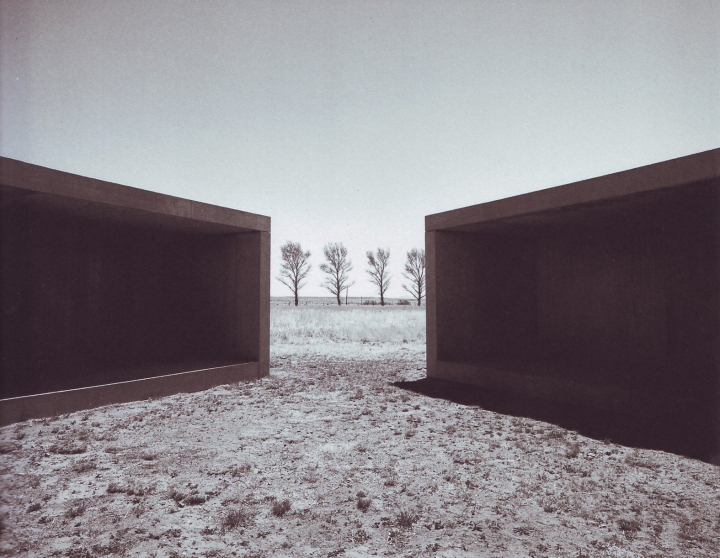
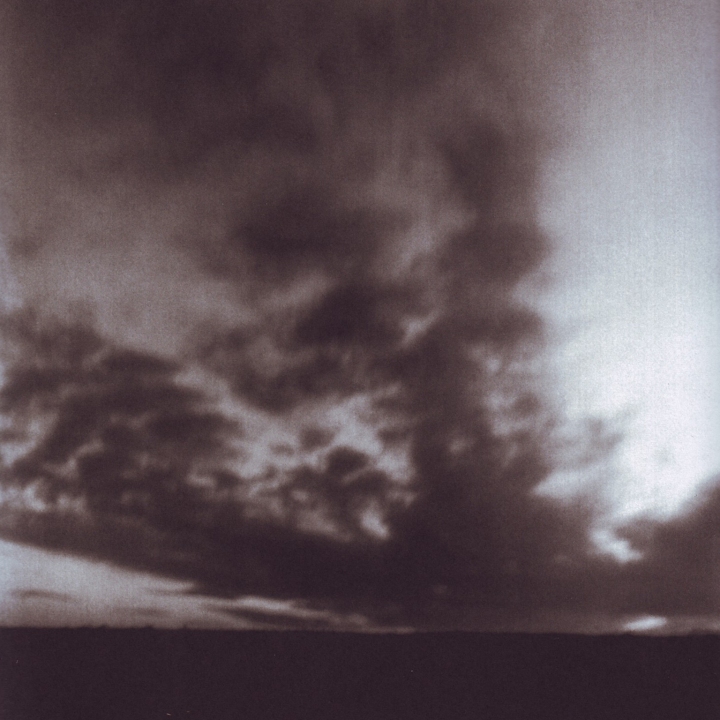

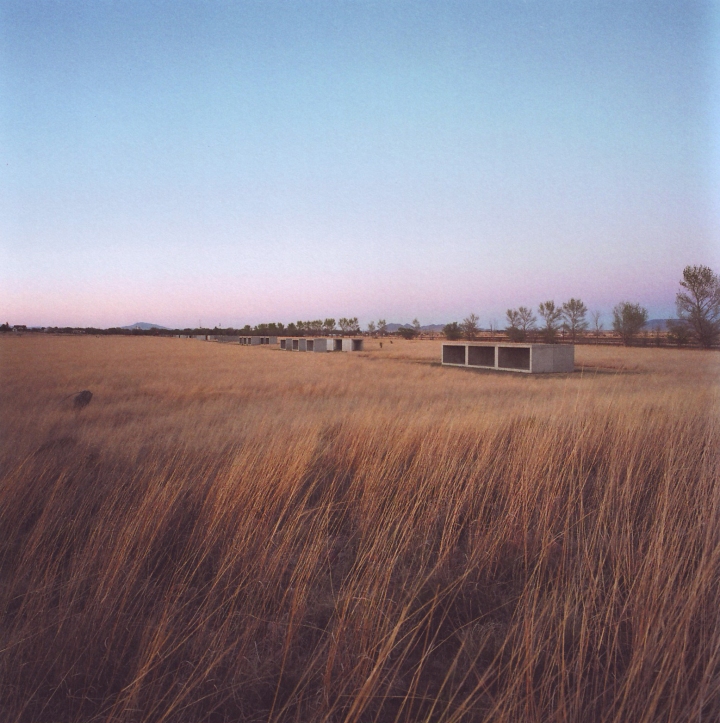

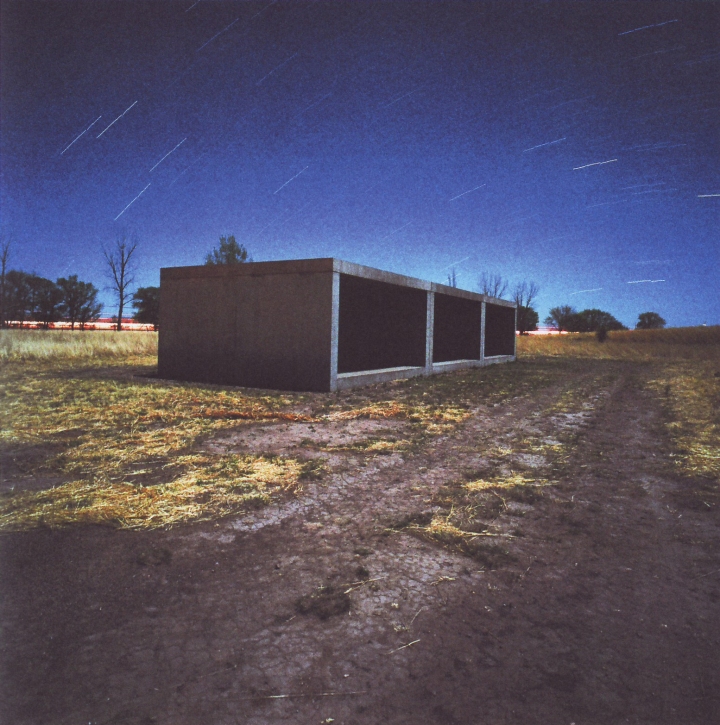
All fifteen concrete works by Donald Judd cast and assembled on-site in Marfa, Texas between 1980 through 1984. Each measures 2.5 x 2.5 x 5 meters.
Shade is short and miles away, tucked between the Chinati mountains and the Mexican border.
In the low, lonely horizontal blue desert plain of the Chihuahuan.
As day dims, light is long.
Bowing towards the horizon, the retiring sun sets the sky ablaze and the desert aglow.
A weightless, soft sensual glow : purple mountain silhouettes, capacious sky, undulating glass, amber cactus and concrete.
Light and dark, land and sky and blue and melt.
The cool, quiet haze of dark generously gives way to starry desert night dreams.
___
A Magazine #9
Proenza Shouler : Tom Watt : Ian Davies : Nathalie Ours
A Publisher
2009
___
A
Robert Smithson
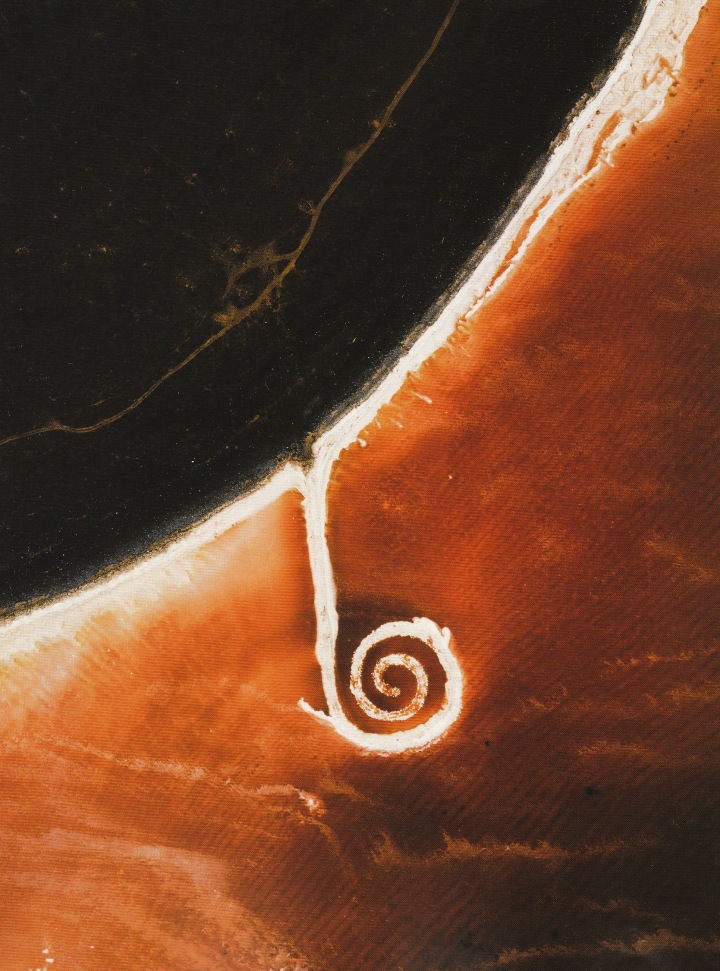
Aerial view of Spiral Jetty (1970), Great Salt Lake, Utah, August 2003. Mud, precipitated salt crystals, rocks and water. Coil: 1500 ft. long and 15 ft. wide. Photographed by David Maisel.
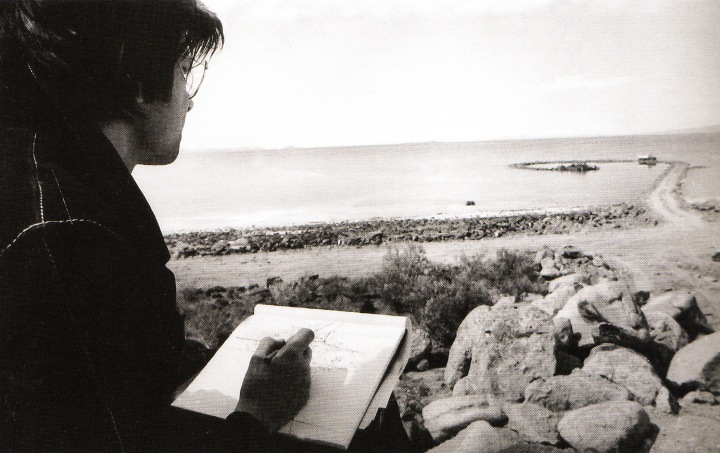
Smithson building Spiral Jetty (1970), Great Salt Lake, Utah, 1 April 1970. Photographed by Gianfranco Gorgoni.
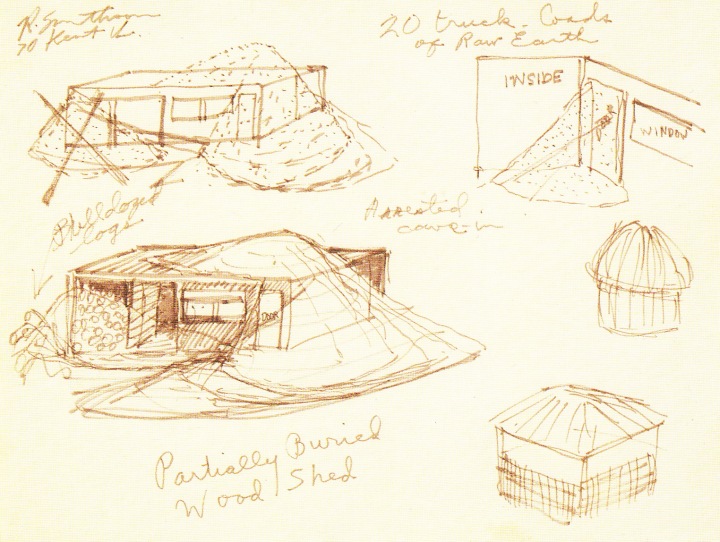
Documentary Drawings for Partially Buried Woodshed, 1970.

Partially Buried Woodshed, 1970.

St. John in the Desert, c. 1961-63.
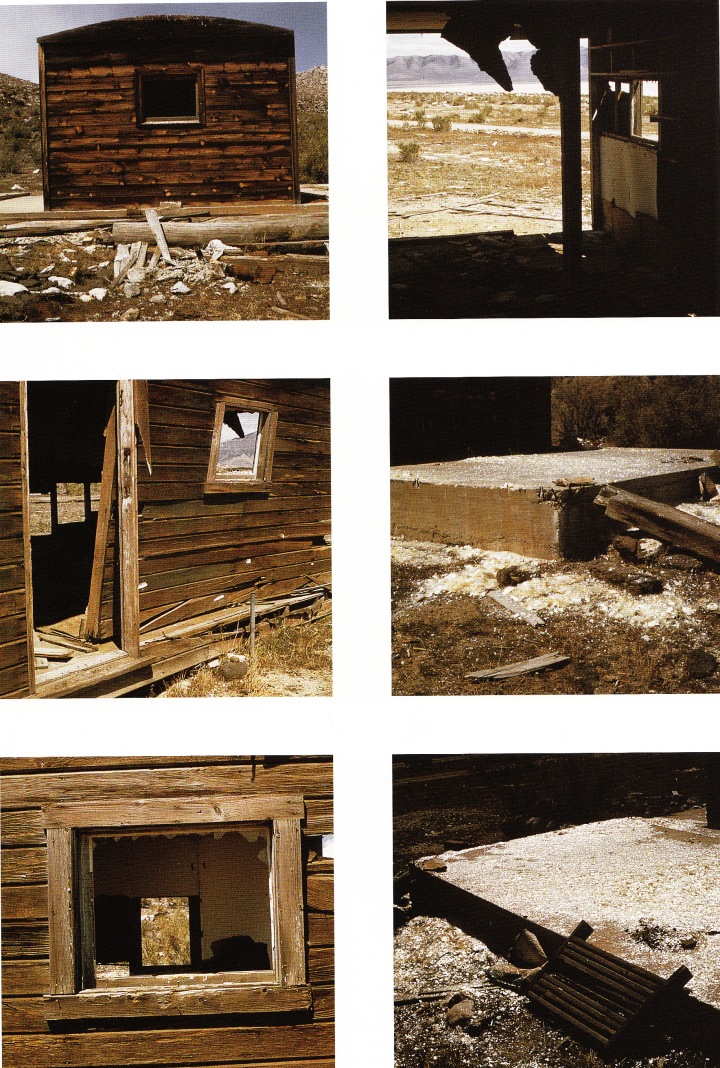
Untitled (Mica Spread) (1970), Rozel Point, Utah, April 1970. Photographed by Nancy Holt.
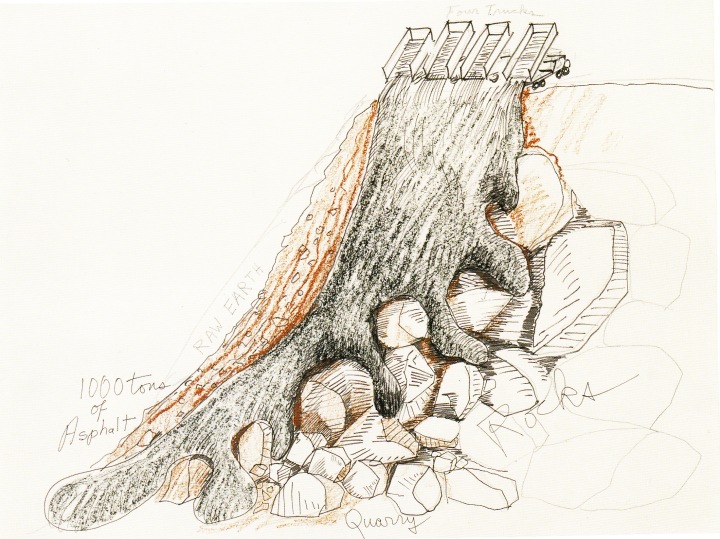
1000 Tons of Asphalt, 1969.
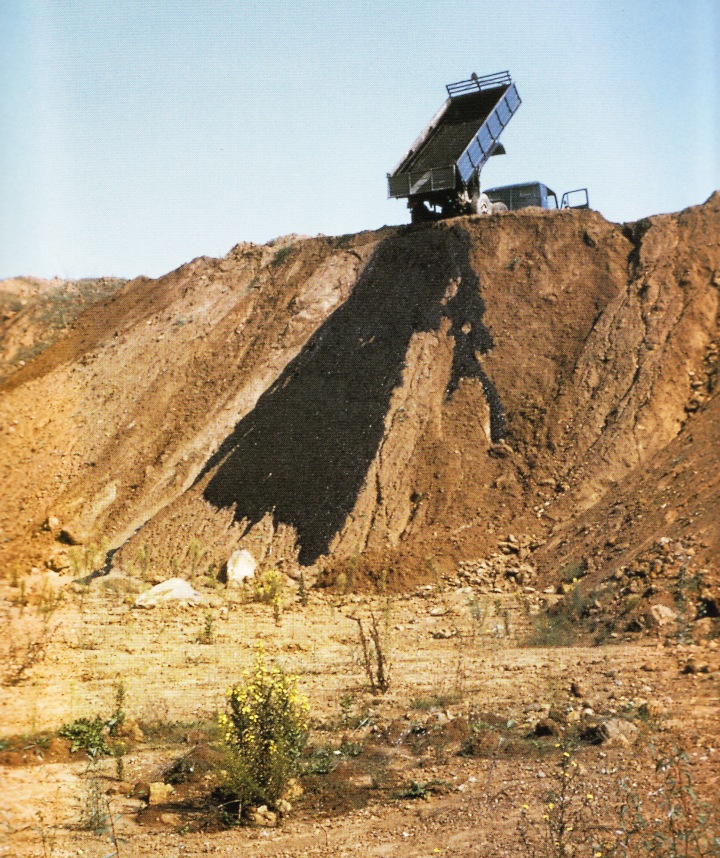
Asphalt Rundown, Rome, 1969.

Spiral Jetty (1970), Great Salt lake, Utah, 1970. Mud, precipitated salt crystals, rocks and water. Coil: 1500 ft. long and 15 ft. wide. Photographed by Gianfranco Gorgoni
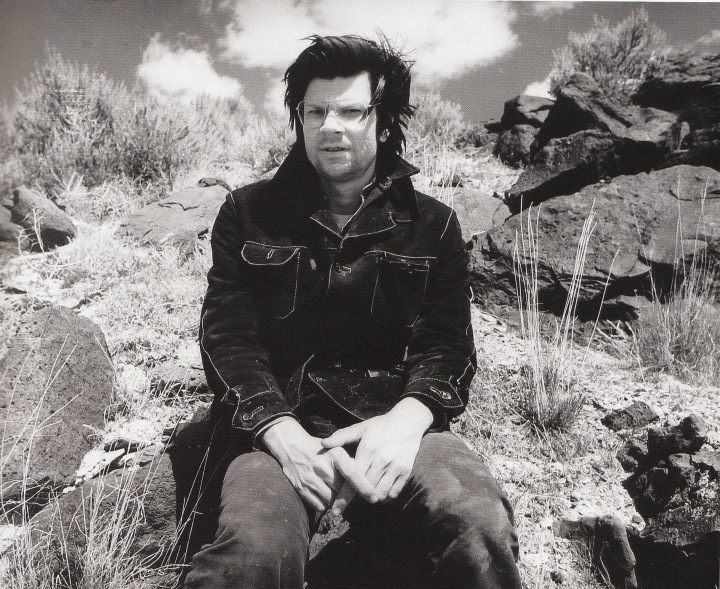
Smithson at the site of Spiral Jetty (1970), Great Salt Lake, Utah, April 1970. Photographed by Gianfranco Gorgoni.
Robert Smithson is perhaps best known as a pioneer of the Earthworks movement and the creator of the iconic Spiral Jetty (1970). However, his involvement in the development of Earthworks is only one of his many contributions to postwar American art. One of the most important concepts Smithson was that of the “site,” a place in the world where art is inseparable from its context. His sites included remote locations like Rozel Point, on the north shore of the Great Salt Lake; the Yucatan Peninsula in Mexico; the art museum and the white cube of the gallery; and the pages of art magazines like Artforum, where he published some of his essays. By encompassing both conventional exhibition venues and far-flung locations within his practice, Smithson performed a kind of institutional critique, pointing to the geographical and cultural limitations that the purportedly neutral spaces of museums impose on art.
___
Robert Smithson
Eugene Tsai : Cornelia Butler
The Museum of Contemporary Art, Los Angeles
2005
___
The Museum of Contemporary Art, Los Angeles
B
Doug Aitken

Blow Debris, 2000. Colour film transferred to 9 channel digital video installation, colour, sound and architectural environment, 21 min. cycle.

Electric Earth, 1999. Colour film transferred to 8 channel laserdisc installation, colour, sound, 9 min. 50 sec. cycle.

Electric Earth, 1999. Colour film transferred to 8 channel laserdisc installation, colour, sound, 9 min. 50 sec. cycle.

Who’s Under The Influence, 1999. Diptych.

Glass Barrier, 2000. C-print mounted on Plexiglas.

Diamond Sea, 1997. Colour film transferred to digital video, 3 channels, 3 projections, 1 monitor, Duratrans backdrop, sound and architectural environment, 10 min. cycle.

Diamond Sea, 1997. Colour film transferred to digital video, 3 channels, 3 projections, 1 monitor, Duratrans backdrop, sound and architectural environment, 10 min. cycle.

2 Second Separation, 2000. C-print mounted on Plexiglas.

Eraser, 1998. Colour film transferred to 7 channel digital video installation, sound and architectural environment, 20 min. cycle.
Amanda Sharp: Director Werner Herzog once explained that his book On Walking in Ice (1979) came about when he found out that a friend of his was dying in Paris. Herzog decided that if he walked from wherever he was – I assume Munich – to Paris, his friend lived: he felt he could keep his friend alive by walking. A work like this is about how individuals can attempt to alter – slow down or speed up – time, how they’re somehow part of a much bigger system.
Doug Aitken: We all encode our experiences of time at different rates. A single moment from several months ago may consume our thoughts, yet a whole summer five years ago may have completely vanished from our memory. We stretch and condense time until it suits our needs. You could say that time does not move in a linear trajectory, and moreover we’re not all following time using the same system.
When I was twenty-one I worked in an editing room for the first time. We were working long hours, day and night, but for me it was a new sensation, fresh and exciting. When finally I could go home to sleep, my dreams were extremely vivid. As I was moving through a dream, I would look down in the lower right hand corner of my dream and see numbers: a time code, like the date-time-minute-frame numbers used in editing raw footage. I was surprised I had never noticed this time code in my dreams before! I also recognized that I no longer needed to watch and witness my dreams passively; I could stop my dream like a freeze frame and look around as if watching a giant, frozen photograph. I could pull back and the dream would rewind so that I could reassemble it in new ways. That night I re-edited my dreams over and over again.
I suppose my working process is very nomadic. I’m not interested in working out of a sterile, traditional, white-cube studio. I’d like to find a methodology that is constantly sight specific, constantly in flux. Some works which are very fictional demand to be built and constructed as if part of a new reality, while others require an intense investigation into a specific landscape. I would like the permanence of my process to be as temporary as possible. I’d like to think of an absence of materialism where at the end of the day, all one needs is a table, a chair, a sheet of paper,possibly less. That would be nice: to be without routine and unnecessary possessions.
Uprooting and removal surrounds us, and at times these can be mirrored in our working process. At times I just let go and am assimilated into my landscapes, other times I feel an active resistance. I think there’s something about growing up in America that makes you feel nothing is ever really stationary. Home can be motion at times*.
*Excerpt from Amanda Sharp in conversation with Doug Aitken.
___
Doug Aitken
Daniel Birnbaum : Amanda Sharp : Jörg Heiser
Phaidon
2005
___
B
Gordon Matta-Clark

Splitting, 1974. Black and white photo collage, 101.5 x 76.2 cm.

Splitting, 1974. Black and white photo collage, 100 x 72 cm.

Splitting, 1974. Black and white photo collage, 100 x 100 cm.

Splitting, 1974. Black and white photo collage, 50 x 60 cm.

Day’s End, 1975. Colour photograph, 96 x 103 cm.

Day’s End, 1975. Cibachrome, 121 x 103.5 cm.

Conical Intersect, 1975. From a series of five colour photographs, 101.6 x 106.7 cm.

Conical Intersect, 1975. From a series of five colour photographs, 101.6 x 106.7 cm.

Conical Intersect, 1975. From a series of five colour photographs, 101.6 x 106.7 cm.

Conical Intersect, 1975. From a series of five colour photographs, 101.6 x 106.7 cm.

Conical Intersect, 1975. From a series of five colour photographs, 101.6 x 106.7 cm.

Conical Intersect, 1975. Cibachrome, 101.1 x 76 cm.

Office Baroque, 1977. Cibachrome, 101.6 x 76.2 cm.

Office Baroque, 1977. Cibachrome, 108 x 58 cm

Office Baroque, 1977. Cibachrome, 101.5 x 75.6 cm.
“I don’t know what the word “space” means…I keep using it. But I’m not quite sure what it means.” – Gordon Matta-Clark.
From 1971 until his death in 1978, the American artist Gordon Matta-Clark produced a body of work popularly known the “building cuts”; sculptural transformations of abandoned buildings paradoxically constructed through the cutting and virtual dismantling of a given architectural site. Situated in places ranging from slums in Manhattan to the waterfront of Antwerp, these works, long since destroyed, appear to comply with the most canonical assumptions of site-specific art in the seventies. On the one hand they demonstrate the commonly accepted notion that the place where the artwork is encountered necessarily conditions its reception, foregrounding as they do the the localized dynamics between institutions, property values and works of art. On the other hand Matta-Clark’s cuttings address the temporality of the built environment, marking the destruction of the buildings that effectively constituted such places.
To read the personal testimonials on Matta-Clark’s work is to sense the experimental limitations of these models, for what marks these accounts is a certain failure of description that attends to the dizzying, at times overwhelming, experience of the building cuts; their unsettling shifts in scale, their Piranesiesque irruptions into architectural mass, their vertiginous drops and labyrinthine passages, their gaping holes, each affording the most disorientating vistas.
___
Gordon Matta-Clark
Thomas Crow : Corrine Diserens : Judith Russi Kirshner : Christian Kravagna
Phaidon
2003
___
Gordon Matta-Clark | Conical Intersect (1975)
B
I Like America and America Likes Me | Joseph Beuys











‘For me it is the idea of the word that produces all images. It is the key sign for all forms of moulding and organizing. When I speak using a theoretical language, I try to induce the impulses of this power, the power of the whole understanding of language which for me is the spiritual understanding of evolution.’
But language is not to be understood simply in terms of speech and words. That is our current drastically reduced understanding of language, a parallel to the reduced understanding of politics and economics. Beyond language as a verbalization lies a world of sound and impulses, a language of primary sound, without semantic content, but laden with completely different levels of information.
Every form of life speaks a language, untapped and unheard.
___
Joseph Beuys : Coyote
Caroline Tisdall
Schirmer/Mosel
1976
___
R
What Remains | Sally Mann

Untitled (Matter Lent)
All things summon us to death;
Nature, almost envious of the good she has given us,
Tell us often and gives us notice that she cannot
For long allow us that scrap of matter she has lent…
She has need of it for other forms,
She claims it back for other works.
Jacques-Bénigne Bossuet (1627-1704), “On Death, a Sermon”

Untitled (Matter Lent)
 Untitled (Matter Lent)
Untitled (Matter Lent)
 Untitled (Matter Lent)
Untitled (Matter Lent)
 Untitled (Matter Lent)
Untitled (Matter Lent)
 Untitled (Matter Lent)
Untitled (Matter Lent)
___
…He must have ditched the shotgun because by the time he approached the house he only had the pistols. Ducking behind a tree, he put one of them to his head. His shot was tinnily distinguishable from the rifle shots of the police who had appeared at the last moment. He fell among the stumps and bracken, just a kid after all, my son’s age, bled out in the milky winter light.

Untitled (December 8, 2000)

Untitled (December 8, 2000)

Untitled (December 8, 2000)

Untitled (December 8, 2000)
___
Pensive on her dead gazing I heard the Mother of All,
Desperate on the torn bodies, on the forms covering the battlefields gazing,
(As the last gun ceased, but the scent of the powder-smoke linger’d,)
As she call’d to her earth with mournful voice while she stalk’d,
Absorb the well O my earth, she cried, I charge you lose not my sons,
lose not an atom
And you streams absorb them well, taking their dear blood,
And you local spots, and you airs that swim above lightly impalpable,
And all you essences of soil and growth, and you my rivers’ depths,
And you mountain sides, and the woods where my dear children’s blood
trickling redden’d

Untitled (Antietam)
And you trees down in your roots to bequeath to all future trees,
My dead absorb or South or North – my young men’s bodies absorb,
and their precious blood,
Which holding in trust for me faithfully back again give me many a year hence,
In unseen essence and odor of surface and grass, centuries hence,
In blowing airs from the fields back again give me my darlings,
give my immortal heroes,
Exhale me them centuries hence, breathe me their breath, let not an atom be lost,
O years and graves! O air and soil! O my dead, an aroma sweet!
Exhale them perennial sweet death, years, centuries hence.
Walt Whitman, from Leaves of Grass
 Untitled (Antietam)
Untitled (Antietam)
 Untitled (Antietam)
Untitled (Antietam)

Untitled (Antietam)

Untitled (Antietam)

Untitled (Antietam)
When the land subsumes the dead, they become the rich body of the earth, the dark matter of creation. As I walk the fields of this farm, beneath my feet shift the bones of incalculable bodies; death is the sculptor of the ravishing landscape, the terrible mother, the damp creator of life, by whom we are one day devoured.
___
What Remains
Sally Mann
Bulfinch Press
2003
___
R
The Matter of Time | Richard Serra

Forming of the plates for The Matter of Time at Pickhan Umformtechnik, Siegen, Germany

Serra (center) and others installing One Ton Prop (House of Cards) at the Museum of Art, RISD, Providence, 1969

Robert Smithson and Richard Serra, 1970

Frames from Hand Catching Lead, 1968

Tilted Arc, 1981. Weatherproof steel, cylindrical section tilted into the ground, 12′ x 120′ (3.66 x 36.58 m), plate thickness 2½” (6.5 cm). General Services Administration, Washington D.C. Installed at Federal Plaza, New York, 1981-89; destroyed by the United States Government, 1989.

Installation of To Encircle Base Plate Hexagram, Right Angles Inverted at 183rd Street and Webster Avenue, Bronx, New York, 1970.

Shift, 1970-72. Concrete, six sections; section one: 5′ x 240′ (1.52 x 73.15 m); section two: 5′ x 150′ (1.52 x 45.72 m); section three: 5′ x 120′ (1.52 x 36.57 m); section four: 5′ x 105′ (1.52 x 32 m); section five 5′ x 110′ (1.52 x 33.52 m); section six 5′ x 90′ (1.52 x 27.43 m); section thickness: 8″ (20 cm). Installed in King City, Ontario, Canada.

Serpentine, 1993. Weatherproof steel, two units, each comprised of two conical sections, each section: 13’2″ x 52′ (4 x 15.85 m); length overall: 104′ (31.7 m): plate thickness 2″ (5 cm). Collection of Frances and John Bowes, Sonoma, California.

Torqued Ellipse II, 1996. Weatherproof steel, 12′ 29′ x 20’5″ (3.66 x 8.83 x 6.22 m); plate thickness: 2″ (5 cm). Dia Art Foundation. Gift of Leonard and Louise Riggio.

Afangar (Stations, Stops on the Road, to Stop and Look: Forward and Back, to Take It All In), 1990. Basalt, eighteen stones; nine: 9’10” x 1’9″ x 1’9″ (3 x .55 x .55 m): nine: 13’1½” x 1’9″ x 1’9″ (4 x .55 x .55 m). City of Reykjavik, Iceland. Installed Videy Island, Reykjavik Harbor.

Richard Serra, photographed by Robert Frank, 2002
The List:
To roll, to crease, to fold, to store, to bend, to shorten, to twist,
to dapple, to crumple, to shave, to tear, to chip, to split, to cut,
to sever, to drop, to remove, to simplify, to differ, to disarrange,
to open, to mix, to splash, to knot, to spell, to droop, to flow,
to curve, to lift, to inlay, to impress, to fire, to flood, to smear,
to rotate, to swirl, to support, to hook, to suspend, to spread,
to hang, to collect –
of tension, of gravity, of entropy, of nature, of grouping,
of layering, of felting –
to grasp, to tighten, to bundle, to heap, to gather, to scatter,
to arrange, to repair, to discard, to pair, to distribute, to surfeit,
to complement, to enclose, to surround, to encircle, to hide,
to cover, to wrap, to dig, to tie, to bind, to weave, to join,
to match to laminate, to bond, to hinge, to mark, to expand,
to dilute, to light, to modulate, to distill –
of waves, of electromagnetism, of inertia, of ionization,
of polarization, of refraction, of simultaneity, of tides, of reflection,
of equilibrium, of symmetry, of friction –
to stretch, to bounce, to ease, to spray, to systematize,
to refer, to force –
of mapping, of location, of context, of time, of carbonization –
to continue.
The “Verb list” established a logic whereby the process that constituted a sculpture remains transparent. Anyone can reconstruct the process of the making by viewing the residue.
The sculptures resulting from the “Verb list” introduced two aspects of time: the condensed time of their making and the durational time of their viewing.
Both tasks and materials were ordinary. I was tearing lead in place, lifting rubber in place, rolling and propping lead sheets, and melting lead and splashing it against the juncture between wall and floor. The activities were experimental and playful. It wasn’t the question of how to accomplish this or that, nor was it the question of making it up as I went along: it was rather a free-floating combination of both.
I cannot overemphasize the need for play, for in play you don’t extract yourself from your activity. In order to invent I felt it necessary to make art a practice of affirmative play or conceptual experimentation. The ambiguity of play and its transitional character provides suspension of belief whereby a shift in direction is possible when faced with a complexity that you don’t understand. Free from skepticism, play relinquishes control. Play allows one to accept discontinuities and continuities; it also allows one to happen upon solutions or invent them. However, even in play the task must be carried out with conviction. It’s how we do what we do that confers meaning on what we have done.
– Richard Serra (excerpt from Questions, Contradictions, Solutions, 2004)
___
The Matter of Time
Richard Serra : Hal Foster : Carmen Giménez : Kate D. Nesin
Steidl
2005
(This publication accompanies the installation of The Matter of Time at the Guggenheim Bilbao. Curated and organized by Carmen Giménez. Sponsored by Arcelor)
___
R
The Bikeriders | Danny Lyon, 2003

Crossing the Ohio, Louisville

Renegade’s Funeral, Detroit

Route 12, Wisconsin

Benny at the Spotlight, Cicero, Illinois

Funny Sonny packing with Zipco, Milwaukee

Barbara at the clubhouse in Chicago

Benny, Grand and Division, Chicago
Last year my girlfriend called me up and she asked me to come down to Grand and Division. She needed some money. And she said it was a bar. She says that the guys are havin’ a meeting there. Well, I didn’t know the guys or anything, so I went there and I never felt so out of place in all my life. I walked in there and had white Levis on, I had a sweater on. And I looked and the first guy I seen was Corky, with an earring hanging out of his ear, his belly button showing, like half naked. To me it was like half naked, you know? And here he’s hootin’ and hollerin’ and he scared the livin’ shit out of me. So I sees my girlfriend and I goes over to her and I sits down there and I’m takin’ everything in. And all these guys kept comin’ up to me sayin’, you know, different stuff like you need a man, or you want to come live with me? And I was about ready to just run. So I says to my girlfriend, well, I gotta go. And she says, oh, they’re not that bad. Just sit here. So all of a sudden I seen Benny and he was standin’ at the end of the bar. And I says to my girlfriend, boy, who’s the good lookin’ blond guy? I says, he don’t look like the rest of these guys. She says, oh Kathy, you don’t want to go out with him. She says, because nobody wants to go out with him. So she ordered me a Coke and I sat there and was shootin’ the breeze with her, and all of a sudden Benny came up behind me and he started talkin’ to me. And I says, well, I gotta go home. So I walks out the front door real nice, bein’ grabbed about five times, so that when I got outside, I could see on my slacks were just hand prints all over me.
So I’m standin’ on the bus corner, almost in tears, thinkin’, oh my God, something’s gonna happen to me yet. And they all come chargin’ out of the front door. They had Benny start up the bike and they grabbed me and they took my purse and they put me on Benny’s bike and they told him to take off. They’d meet him on the expressway. He takes off. He goes through the stoplights and everything, so that I wouldn’t jump off. And I wouldn’t have jumped off anyway ‘cause I was scared shitless. I never was on a motorcycle in all my life. So we went to the Green Duck out on River Road. But before we got there I’m sittin’ on the bike real nice. I figure, you know, at least he’ll get me home. All of a sudden he takes his hand, he puts it on my back like this. I said, whatta you doin’? He says, I’m just checkin’ so you don’t fall off. I says, OK, like an idiot you know? I thought he was really checkin’ it out. So the second time it happened, I says, don’t worry about me, I says, I won’t fall off. He says, okay, and he was real nice about it. Five weeks later I married him. I ain’t real sorry. The only thing is I thought I could change him, you know? Every woman thinks that she can change a guy. Not to her own ways, but to be different. Not to be different, but to be, I don’t know. Like he’s wild. I used to think he’d get over that. But he don’t. And he’s got a vicious temper. He’s got a temper that all you have to do is say two words and he’ll knock you on your rear end. And I ain’t used to that. And I ain’t gettin’ used to that, ‘cause like I told him, I don’t look good in black and blue. And I know the bleeding stops, but still, one of these days. I ain’t got that much blood left.
Were you at the Spotlight when he got worked over that time? You shoulda seen him. His whole head was black and blue, his kidneys were kicked in. His back had scabs on it. He was bleedin’ all over the place. He just stood there. You know what the guys in the club said? Well, one thing we gotta say about Benny, he’s the only guy that stood on his feet from the clubroom all the way out to the street without fallin’ down. And there were guys hittin’ him with stools and blackjacks and everything else. That’s the only thing they say. When he got in trouble once before he put his fist through a window on Broadway and Belmont and the guys, well, he got into a fight and he missed the guy and he went right through the window. His whole hand was wide open, and he was still fightin’. And the first thing the guys said, well, Benny doesn’t give up. He sees a little blood, he doesn’t pass out. They like him because he’s a fighter. And that’s just what they need in that club.
– Kathy, Wife of Benny, Member of the Chicago Outlaws.
___
The Bikeriders
Danny Lyon
Chronicle Books LLC
2003
___
A
Fluxus | Fluxus, 1995

Joseph Beuys, Manifesto, 1970. Alteration of George Maciunas’ Fluxus Manifesto, February 1963.
From 1. Karton, Edition Hundermark, Berlin 1970. 30 x 21 cm

Fluxus Collective Editions, 1963 – 1965

Fluxus Street Events, March – May 1964. Photograph by George Maciunas

Dick Higgins, Danger Music No.2, 1962. Performance at Fluxus Internationale Festspiele Neuester Musik, Wiesbaden 1962. Photograph by Hartmut Rekort

George Maciunas, Dick Higgins, Wolf Vostell, Benjamin Patterson & Emmett Williams performing Philip Corner’s Piano Activities at Fluxus Internationale Festspiele Neuester Musik, Weisbaden 1962. Photograph by Hartmut Rekort

Takeshia Kosugi, Anima I & Ben Vautier, Attaché de Ben & George Maciunas, Solo for Violin.
Simultaneous performance, May 23rd 1964, by Ben Vautier and Alison Knowles (not pictured) during “Fluxus Street Theatre” as part of “Fluxus Festival at Fauxhall” New York City. Photography by George Maciunas. 51 x 40.5 cm

La Monte Young, The Tortoise Droning Selected Tigers From the Holy Numbers for the Two Black Tigers, The Green Tiger and the Hermit, from: The Tortoise, His Dreams and Journeys.
Performed 1964 at the Pocket Thetare, New York. From left; Tony Conrad, Marian Zazeela, La Monte Young and John Cale. Photo by George Maciunas
Fluxus is not: a movement, a moment in history, an organization. Fluxus is: an idea, a kind of work, a tendency, a way of life, a changing set of people who do Fluxworks -Dick Higgins.
Taken from the Latin word meaning “to flow”, the origins of Fluxus began in the early 1960s with Lithuanian born George Maciunas (1931 – 1978) who’s ideology quickly attracted a large network of artists, composers and designers who continue to express his extraordinary vision in the manifestation of anti-art, encompassing everything from music, photography, sculpture, installation, publications and pavement art to poetry and drama.
Beginning with a series of festivals featuring concerts of new experimental music and other avant-garde performance, Fluxus artists reacted against the commodity status of art, its commercialization in the gallery system, and its static presentation in traditional institutions. They often rejected the concept of artistic genius and single authorship in favor of a collective spirit and a collaborative practice.
Fluxus compositions or scores for performances and events involve simple actions, ideas, and objects from everyday life. Some scores, such as those in George Brecht’s Water Yam (1972), were printed on cards and then packaged into plastic boxes and sold as inexpensive multiples. These scores call for open-ended actions and events that can be performed by anyone at any time in any place. Also on view is Yoko Ono’s Invitation to Participate in a Water Event, in which she invited people to bring containers to her 1971 exhibition. These vessels were filled with water, displayed in the show, and labeled as collaborative works of art.
Sometimes a documentation or artifact from a Fluxus event became a work of art, a material presence that referred to an absent action or previous performance. Alison Knowles’ Journal of the Identical Lunch (1971), documents her ritual noontime performances at a New York diner with various artists and friends. In Dick Higgins’ ongoing series, The Thousand Symphonies, he composes musical scores with bullet holes and paint on sheet music. The result is both a documentation of the artist’s action and a work of visual art.
Incorporating musical compositions, concrete poetry, visual art, and writing, Fluxus performances embody Higgins’ idea of “intermedia”- a dialogue between two or more media to create a third, entirely new art form. Fluxus performance also incorporates actions and objects, artists and non-artists, art and everyday life in an attempt to find something “significant in the insignificant.” The influence of this highly experimental, spontaneous, often humorous form of performance art prevailed through the 1970s and has been rediscovered by a younger generation of artists working today.
___
Fluxus
Thomas Kellein : George Maciunas : Jon Hendricks
Thames & Hudson
1995
___
B
Radio Silence | A Selected Visual History of American Hardcore Music

Cassette Demos, 1985 – 89.

Antioch Arrow at 915 E. Street. San Diego, California, May 1993.

Hand Painted Leather Jacket, 1986.

Universal Order of Armageddon Demo, Vermin Scum Records, 1992.

Hand Drawn ‘Straight Edge’ T-Shirt, 1982.

Dance Floor at the Wilson Center, Summer 1982.

“Fuck You HBPD” Sticker, 1986.

Minor Threat, Salad Days 7″ (Back Cover Detail), Dischord Records, 1985.

Skate Rock Vol. 03, ‘Wild Riders of Boards’ 12″, High Speed Productions, 1985.
In the late 1960s, two bands hailing from Michigan laid the groundwork for punk. The Motor City Five and The Stooges aren’t the center ring on punk’s tree, but they stand as the most recognizable starting point. Both bands’ revved-up version of the blues garnered attention, major label deals, and devout fans, but the landscape wasn’t yet ripe for a revolution. Ultimately, a shitload of heroin and the typical cast of clueless suits caused both bands to end prematurely.
And while wearing swastikas for shock value, disrespecting the Royal Family, and displaying a disdain for anything considered “normal” was punk’s calling card, its roots remained firmly in the streets of New York, the art scene of Los Angeles, and London fashion; places totally foreign to kids in suburban America. As romantic as it was to be a starving artist living like shit in New York City most kids just fucking hated their parents and liked to light fires in the woods.
As punk migrated to the suburbs the sound and attitude changed. Something snapped in American culture; kids who loved the speed and fuck you attitude of punk took hold of its spirit, got rid of the “live fast, die young” bullshit and made a revision: hardcore. It wasn’t a direct fuck you to punk’s aesthetic and sound, hardcore was moving too fast to give a shit. With an actor elected as President and a defense initiative named after Star Wars, the decade was as dire as it was absurd. Cocaine was huge, AIDS surfaced as global epidemic, and the suburbs were really fucking boring. Hardcore’s direct and naïve stood out as the most honest commentary put to music at the time.
– Anthony Pappalardo, Instinct and Attitude: The Art of Necessity
___
Radio Silence| A Selected Visual History of American Hardcore Music
Nathan Nedorostek : Anthony Pappalardo
MTV Press
2008
___
A
4 comments